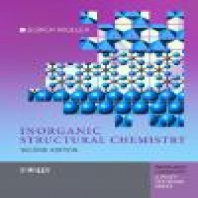Inorganic Structural Chemistry describes the structural principles of inorganic molecules and solids using traditional concepts as well as modern approaches. It includes the systematic ordering of the recognized structure types, relationships amongst them, and the link between structure and properties. Contents Include: how to describe chemical structures, symmetry, phase transitions and phase diagrams, the interplay of chemical bonding-energy-structure, factors governing the structure of ionic compounds, molecules and metals, chemical bonding in solids - band theory, structural principles of polyanionic, polycationic and cluster compounds, structure of the elements, sphere packings in metals and compounds, solid state structures seen as arrays of linked polyhedra and as sphere packing with occupied interstices, symmetry as an ordering principle of crystal structures, physical properties of solids, nanostructures.In this second edition of this popular textbook, the text has been revised and new scientific findings have been taken into consideration. For example, many recently discovered modifications of the elements have been included, most of which occur at high pressures. Particular attention is given to the treatment of symmetry throughout the book. New sections deal with quasicrystals and other not strictly crystalline solids, with phase transitions and with the electron localization function. There is a new chapter on nanostructures.
Inorganic Structural Chemistry
| Người gửi: | Phí Đình Thảo |
| Ngày đăng: | 25/01/2021 |
| Đánh giá: | |
| Votes: | 0 |
| Nhận xét: | 0 |
| Lượt xem: | 454 |
| Download: | 0 |
| Loại tài liệu: | Free |
Mô tả:
Inorganic Structural Chemistry describes the structural principles of inorganic molecules and solids using traditional concepts as well as modern approaches. It includes the systematic ordering of the recognized structure types, relationships amongst them, and the link between structure and properties. Contents Include: how to describe chemical structures, symmetry, phase transitions and phase diagrams, the interplay of chemical bonding-energy-structure, factors governing the structure of ionic compounds, molecules and metals, chemical bonding in solids - band theory, structural principles of polyanionic, polycationic and cluster compounds, structure of the elements, sphere packings in metals and compounds, solid state structures seen as arrays of linked polyhedra and as sphere packing with occupied interstices, symmetry as an ordering principle of crystal structures, physical properties of solids, nanostructures.In this second edition of this popular textbook, the text has been revised and new scientific findings have been taken into consideration. For example, many recently discovered modifications of the elements have been included, most of which occur at high pressures. Particular attention is given to the treatment of symmetry throughout the book. New sections deal with quasicrystals and other not strictly crystalline solids, with phase transitions and with the electron localization function. There is a new chapter on nanostructures.
Mua lượt tải
Tiết kiệm chi phí
Số ngày hết hạn tính theo gói cao nhất còn giá trị
Với nhiều ưu đãi hấp dẫn





















